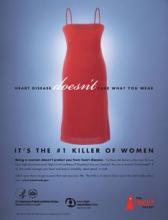The study, presented at the recent American College of Cardiology meeting, found that the overall incidence of acute MI decreased among 315,246 patients admitted to New Jersey hospitals 1986-2007. The decrease was significant among both men and women, but was more prominent among men.
The incidence of acute MI fell from 598 to 311 per 100,000 men and from 321 to 197 per 100,000 women, according to cardiologist Dr. Liliana Cohen and her colleagues at the Robert Wood Johnson Medical School in New Brunswick, N.J. They also identified a growing gap in the rates of left heart catheterization and percutaneous coronary intervention between men and women.
The rates of catheterization increased fivefold in women and threefold in men over the 22-year study period, but the likelihood of catheterization remained lower for women. Moreover, the difference among male and female cath patients going on to receive PCI increased from 2.2% in 1986 to 9.4% in 2007.
Finally, both in-hospital and 1-year mortality remained higher among women, and failed to show a significant decrease after 2002 – the year the National Heart Lung and Blood Institute launched the Red Dress campaign.
“Although awareness of cardiovascular disease in women has increased in the general population, there has been much less translation of this into clinical practice,” Dr. Cohen told me.
This may be due to women presenting later because they doubt an MI can happen to them or that physicians still are not treating women as aggressively as they treat men, she said. It also may relate to the fact that women have more difficult cardiac anatomy, so that once they receive cardiac cath, PCI remains difficult.
Dr. Cohen suggests that in its next phase, the campaign needs to continue to focus on public health awareness, but also on research into how to translate public awareness into clinical practice by focusing on physicians and into newer techniques of PCI for the smaller blood vessels in women.
Quibble if you will about the generalizability of data from a single state or the potential impact of a single PR campaign, but it’s hard to ignore these disappointing outcomes.
I once heard a bold and blistering guest lecture at a cancer meeting by Nancy Goodman Brinker, founder and CEO of Susan G. Komen for the Cure, who told several thousand — mostly male — oncologists that a survival rate topping 90% for early stage breast cancer simply wasn’t good enough. Truer words were never spoken.



